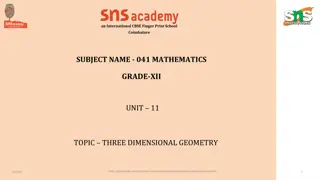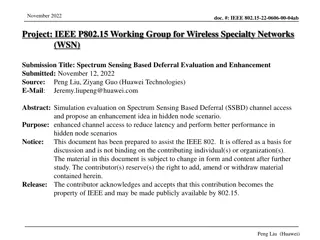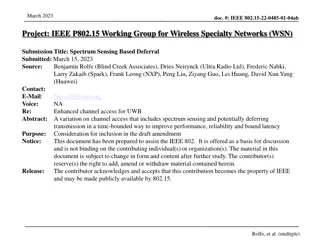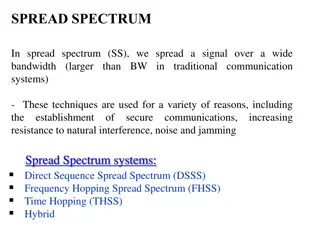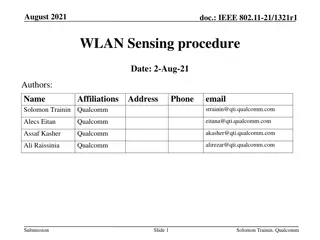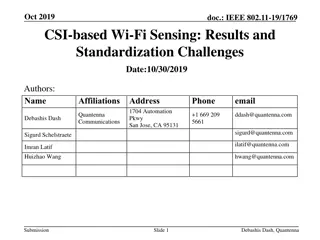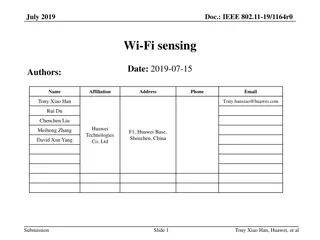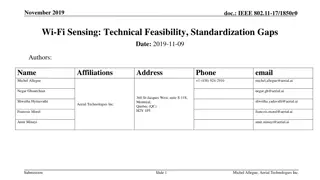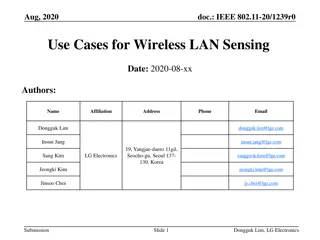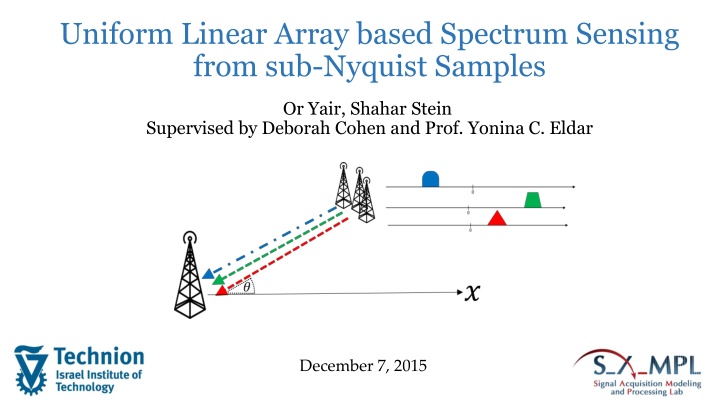
Linear Array-Based Spectrum Sensing and Reconstruction Technique
Explore a novel approach for spectrum sensing and signal reconstruction using a Uniform Linear Array system with sub-Nyquist sampling. The proposed algorithm leverages a modified sampling chain and known transmission parameters to achieve blind signal reconstruction with high accuracy.
Download Presentation

Please find below an Image/Link to download the presentation.
The content on the website is provided AS IS for your information and personal use only. It may not be sold, licensed, or shared on other websites without obtaining consent from the author. If you encounter any issues during the download, it is possible that the publisher has removed the file from their server.
You are allowed to download the files provided on this website for personal or commercial use, subject to the condition that they are used lawfully. All files are the property of their respective owners.
The content on the website is provided AS IS for your information and personal use only. It may not be sold, licensed, or shared on other websites without obtaining consent from the author.
E N D
Presentation Transcript
Uniform Linear Array based Spectrum Sensing from sub-Nyquist Samples Or Yair, Shahar Stein Supervised by Deborah Cohen and Prof. Yonina C. Eldar December 7, 2015
Signal Model Multiband sparse signal Each transmission ?? corresponds to a carrier frequency, ?? Each transmission ?? is narrow band of maximum bandwidth ? All transmissions are assumed to have identical and known angle of arrival ? 90? Goal: Perfect blind signal reconstruction from sub- Nyquist samples 2
Proposed Algorithm We suggest a ULA based system Each sensor of the array, followed by one branch of the MWC with the same periodic function Each sampler is of rate ? From the samples we can form a classic DOA equation? = ??and use known techniques to obtain ? We show that the a sufficient condition is ? + ? samplers 3
System Description The received signal at the ? th sensor: ???? ??2???(?+??) ??? ?=1 ?2(? ?2) ?1(? ?1) ?3(? ?3) 0 ? The mixed signal after multiplying with periodic function: ???? ?? ?????2????? ??? = ?= ?? ?=1 0 4
System Description The filtered signal at the baseband: ??? ??2????? , ? ??? = ?=1 ?0 ??? = ????? ?? ??? ?= ?0 0 The sampled signal: ? ????2???? = ????2??????2????? ?=1 ??? = ??(???) The unknown frequencies are held at the relative accumulated phase 5
Sampling Scheme Modified MWC sampling chain. All sensors use the same periodic function with period ?? Single sensor output: 6 Sufficient condition on ??,??: ?? ?? ?
Sampling Scheme Our measurements The sampling scheme is simpler than the MWC, since the same sequence can be used in all cannels 7
Basic Equation Similar to classic DOA equation Source Signal vector is scaled and cyclic-shifted 0 | | | ? ?1 ? ?2 ? ?3 0 0 | | | ?? ? 0 0 0 0 ? ??2???? ? ??2???? Goal: estimate ? and ? 8
Reconstruction Steps 1. Estimate all frequencies ??. 2. Reconstruct the steering matrix ? ? . 3. Calculate ? = ? ? 4. Uniquely recover ?from ?. 9
Theorem For multiband signal (as presented), If the following conditions hold: Minimal number of sensors: ? + 1 ??= ??> ? ? < ???? p ? = ?= ???2?????, ?? 0, ?: ??? Then: ??,??? can be perfectly reconstructed ? ???? 2 Achievable sampling rate: ? + ? ? 10
Simulations For the ULA based system 2 reconstruction methods were tested: ESPRIT analytic method based on SVD MMV CS method based on OMP algorithm The performance were compared against the MWC Both systems used the same amount of samplers At the ULA based system the number of sensors At the MWC the number of branches 11
Simulations Performance against different number of sensors For the MWC system: the amount of branches SNR 10dB Number of Snapshots 400 Number of Signals 3 ? ????? ???? ????? ?? ????? 12
Simulations Performance against different SNR Number of Sensors 10 Number of Snapshots 400 Number of Signals 3 ? ????? ???? ????? ?? ????? Sampling Rate: ?????? 13
Summary We suggest an ULA based system for the spectrum sensing problem In each sensor of the array, we sample using one branch of the MWC with the same periodic function We relate the unknown parameter and signal to the sub-Nyquist samples We show that a sufficient condition for perfect recovery are ? + ? sensors, each sampling at rate ? We perform parameter estimation out of the DOA equation 14
Questions? Thank you for listening 15


